Evaluation of Mechanical Properties of Different Casing Drilling Steels
Abstract
:1. Introduction
2. Materials and Methods
3. Results
3.1. Microstructure Characterization
3.2. Hardness and Tensile Behavior
3.3. Impact Behavior
3.4. Fatigue Crack Growth Behaviors
4. Conclusions
Author Contributions
Funding
Data Availability Statement
Conflicts of Interest
References
- Patel, D.; Thakar, V. A review on casing while drilling technology for oil and gas production with well control model and economical analysis. Petroleum 2019, 5, 1–12. [Google Scholar] [CrossRef]
- Osman, O.; Merah, N. Casing Wear and Wear Factors: New Experimental Study and Analysis. Materials 2022, 15, 6544. [Google Scholar] [CrossRef] [PubMed]
- Cirimello, P.; Otegui, J. Failure and integrity analysis of casings used for oil well drilling. Eng. Fail Anal. 2017, 75, 1–14. [Google Scholar] [CrossRef]
- Wang, G.; Li, W. Technological Process of the Composite Casing Drilling Technology in Deep-Water Riserless well Construction. Chem. Tech. Fuels Oil 2022, 58, 95–103. [Google Scholar] [CrossRef]
- Bailey, G.; Strickler, R.; Hannahs, D.; Kamruzzaman, S. Evaluation of a Casing Drilling Connection Subjected to Fatigue and Combined Load Testing. In Proceedings of the Offshore Technology Conference, Houston, TX, USA, 1–4 May 2006. [Google Scholar]
- Zhao, Z.; Gao, D.L. Casing strength degradation due to torsion residual stress in casing drilling. J. Nat. Gas Sci. Eng. 2009, 1, 154–157. [Google Scholar]
- Samit, G.; Sean, E. API Specification 5CT N-80 Grade Casing May Burst or Part Unexpectedly if Supplementary Metallurgical Requirements are not Specified. In Proceedings of the SPE/IADC Drilling Conference, Amsterdam, The Netherlands, 23–25 February 2005. [Google Scholar]
- Gruben, G.; Dillingh, B. Thermo-mechanical tensile testing of geothermal casing materials. Geothermics 2021, 89, 101944. [Google Scholar] [CrossRef]
- Dillingh, B.; Thorbjornsson, G.S.K.I. Tensile Testing of Casing Material at Elevated Temperatures up to 550 °C. In Proceedings of the World Geothermal Congress, Reykjavik, Iceland, 26 April–2 May 2020. [Google Scholar]
- Lei, S.; Wei, M. Impact Test and Error Analysis of N80 Waterproof Casing. AMR 2013, 816, 317–321. [Google Scholar]
- Lu, M.; Zheng, X. A new microcomputer-aided system for measuring fatigue propagation threshold and selection testing parameters. Eng. Fract. Mech. 1993, 45, 889–896. [Google Scholar] [CrossRef]
- Fernandez-Vicente, A.; Cars, M.; Penalba, F.; Taleff, E.; Ruano, O. Toughness dependence on the microstructural parameters for an ultrahigh carbon steel (1.3 wt.% C). Mater. Sci. Eng. A 2002, 335, 175–185. [Google Scholar] [CrossRef]
- Zvirko, O.; Tsyrulnyk, O. Evaluation of Corrosion, Mechanical Properties and Hydrogen Embrittlement of Casing Pipe Steels with Different Microstructure. Materials 2021, 14, 24. [Google Scholar] [CrossRef] [PubMed]
- Li, M.F.; Cao, L.H. An Experimental Study on Mechanical properties of P110S under Dynamic Loads. IOP Conf. Ser. Mater. Sci. Eng. 2018, 392, 62020. [Google Scholar] [CrossRef]
- Zhang, H.; Luo, Q. Fracture Failure Analysis of N80 Q Marine Casing. In Applied Mechanics and Materials; Trans Tech Publications Ltd.: Bach, Switzerland, 2013; Volume 318, pp. 331–335. [Google Scholar]
- Balart, M.; Knot, J. Low temperatFure fracture properties of DIN 22NiMoCr37 steel in fine-grained bainite and coarse-grained tempered embrittled martensite microstructures. Eng. Fract. Mech. 2008, 75, 248–251. [Google Scholar] [CrossRef]
- Fuchs, H.O. Metal Fatigue in Engineering; John Wiley & Sons: Hoboken, NJ, USA, 1980; pp. 70–82. [Google Scholar]
- Tuma, J.V. Low-temperature tensile properties, notch and fracture toughness of steels for use in nuclear power plant. Nucl. Eng. Des. 2002, 211, 105–119. [Google Scholar] [CrossRef]
- Sakuma, Y.; Matlock, D.K.; Krauss, G. Mechanical behavior of an intercritically annealed and isothermally transformed low C alloy steel with ferrite-bainite-austenite microstructures. J. Heat Treat. 1990, 8, 109–120. [Google Scholar] [CrossRef]
- Hwang, B.; Lee, C. Influence of thermomechanical processing and heat treatments on tensile and Charpy impact properties of B and Cu bearing high-strength low-alloy steels. Mater. Sci. Eng. A 2010, 527, 4341–4346. [Google Scholar] [CrossRef]
- Hwang, B.; Lee, C.; Lee, S. Microstructure and mechanical properties of ultra-high strength steel plates with deformability. Mater. Sci. Forum. 2010, 638–642, 3266–3271. [Google Scholar] [CrossRef]
- Saeidi, N.; Ekrami, A. Impact properties of tempered bainite-ferrite dual phase steels. Mater. Sci. Eng. 2010, 527, 5575–5581. [Google Scholar] [CrossRef]
- Maweja, K.; Mater, W.S. The design of advanced performance high strength low-carbon martensitic armour steels Part 1. Mechanical property considerations. Mater. Sci. Eng. A 2008, 485, 140–153. [Google Scholar] [CrossRef]
- Paris, P.; Erdogan, F. A critical analysis of crack propagation laws. Trans. ASME Ser. D 1963, 85, 528–535. [Google Scholar] [CrossRef]
- Sankaran, S.; Sarma, V.; Padmanabhan, K.A. High cycle fatigue behaviour of a multiphase microalloyed medium carbon steel: A comparison between ferrite–pearlite and tempered martensite microstructures. Mater. Sci. Eng. A 2003, 362, 249–256. [Google Scholar] [CrossRef]
- Suresh, S. Fatigue of Materials; Cambridge University Press: Cambridge, UK, 1991. [Google Scholar]
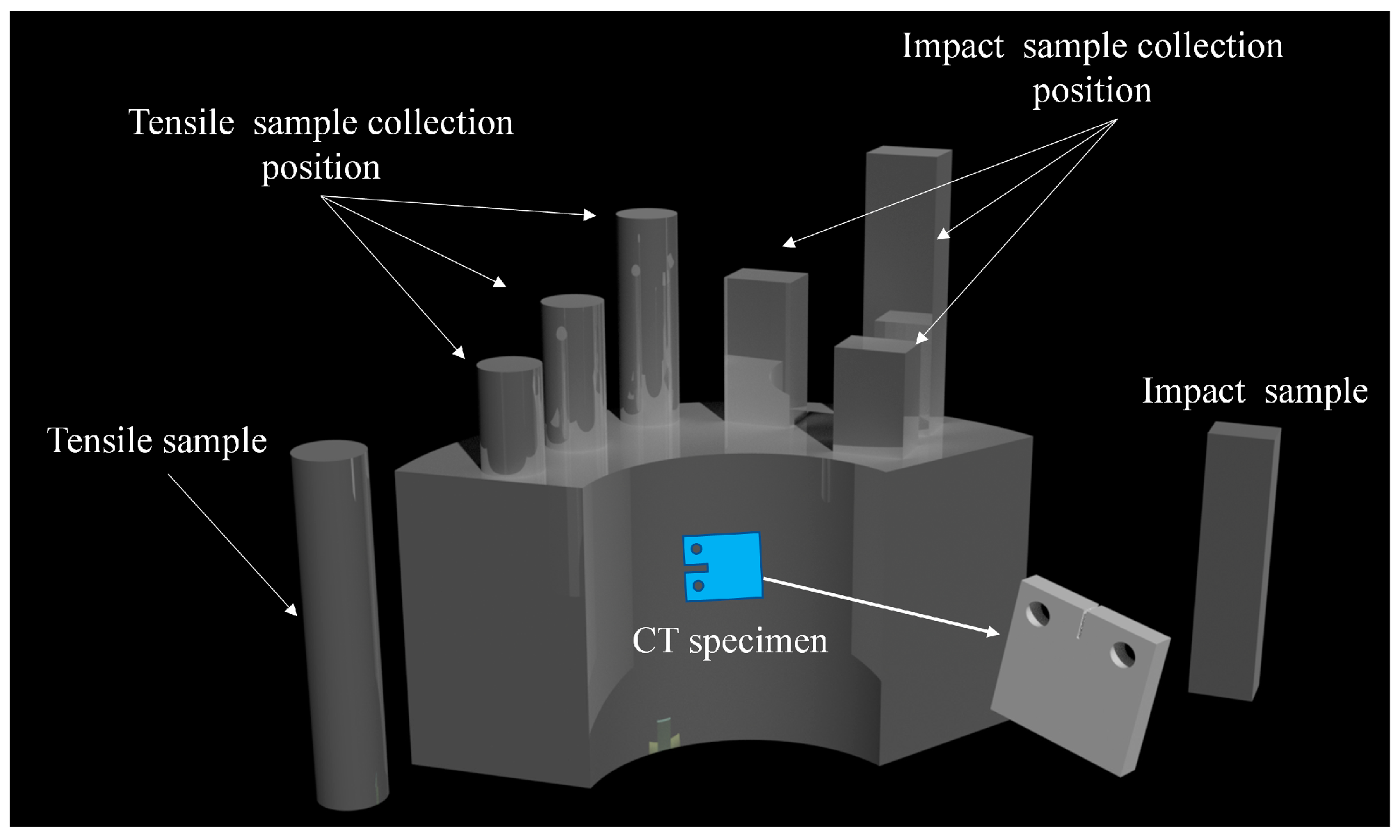
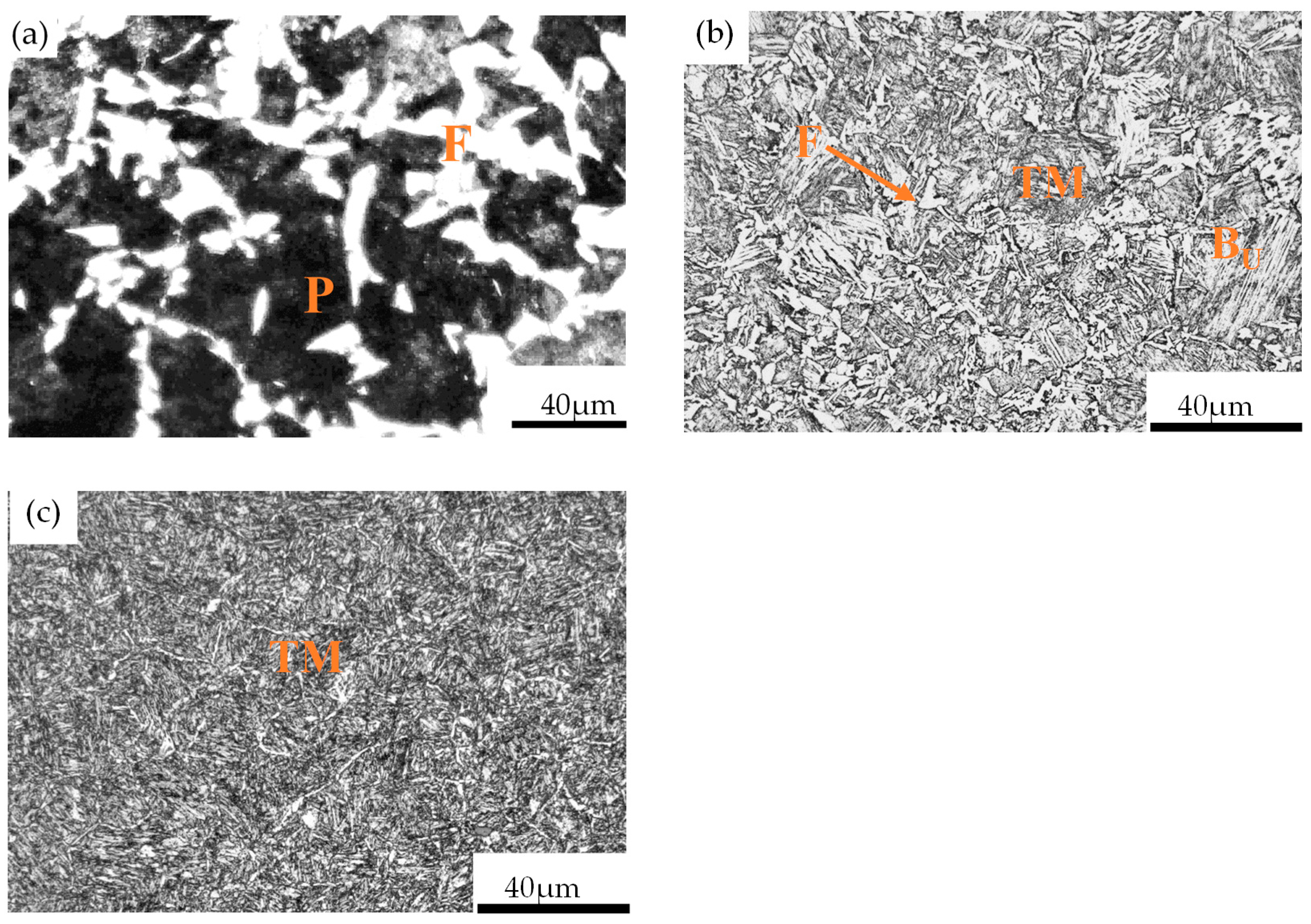
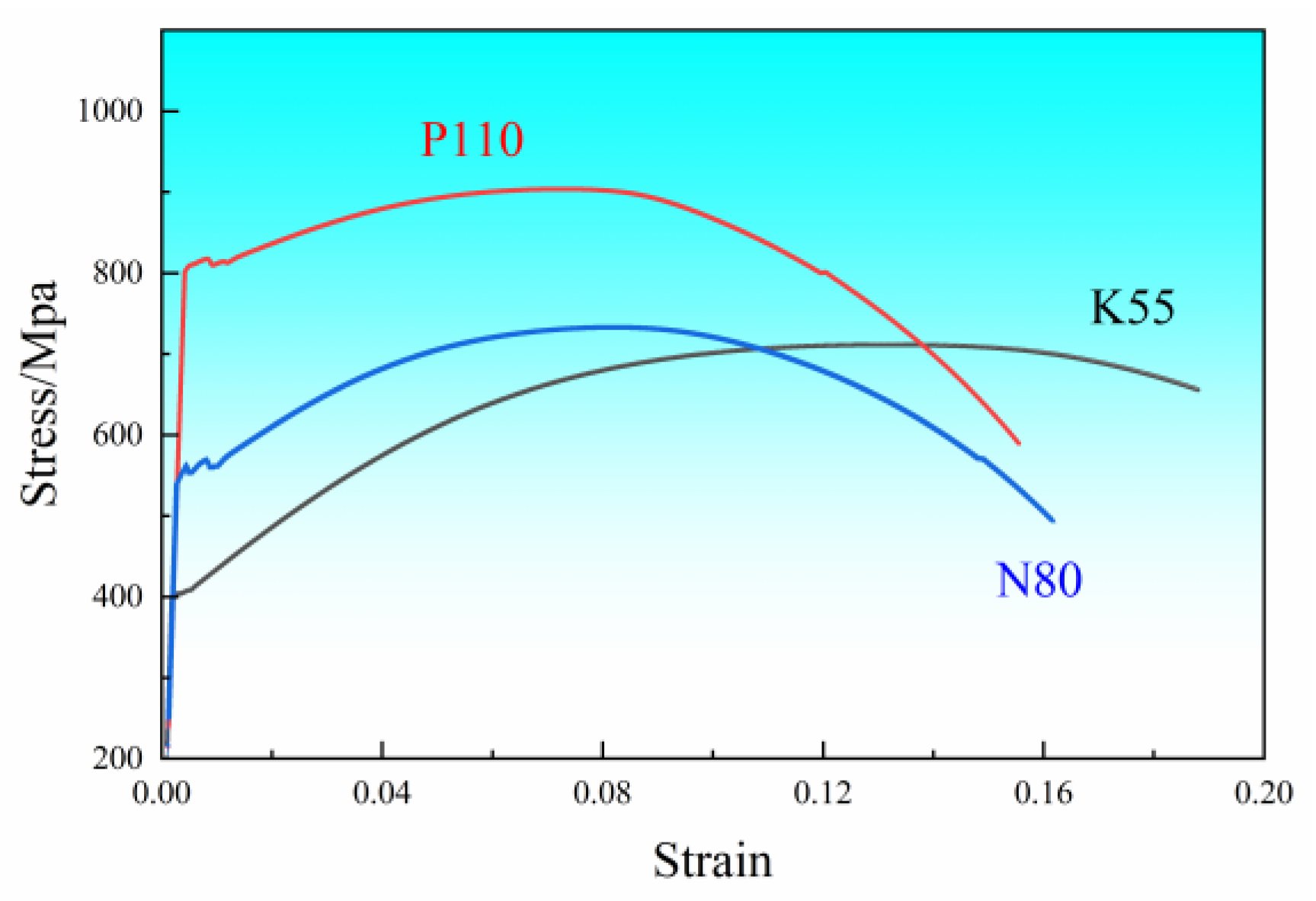

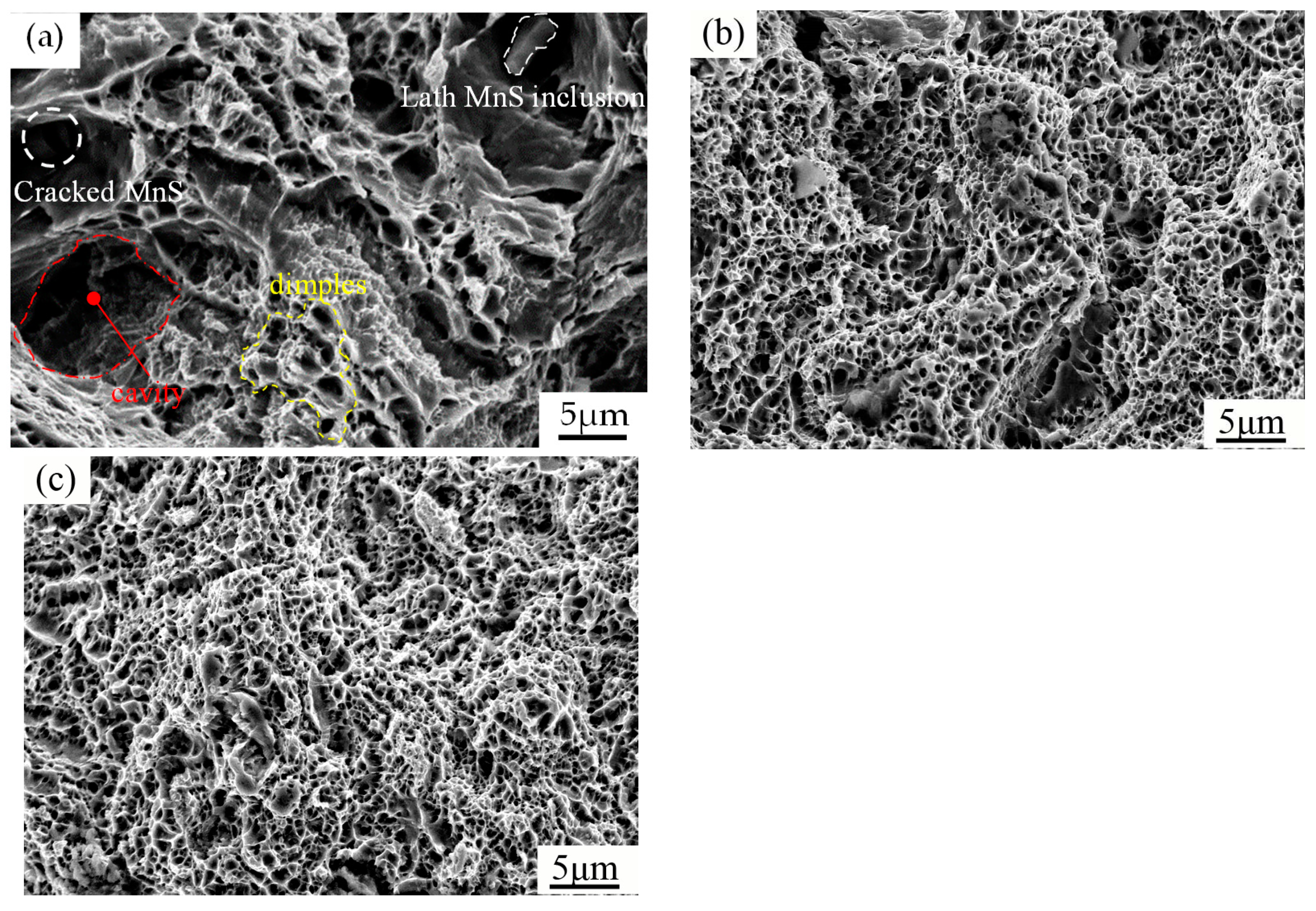
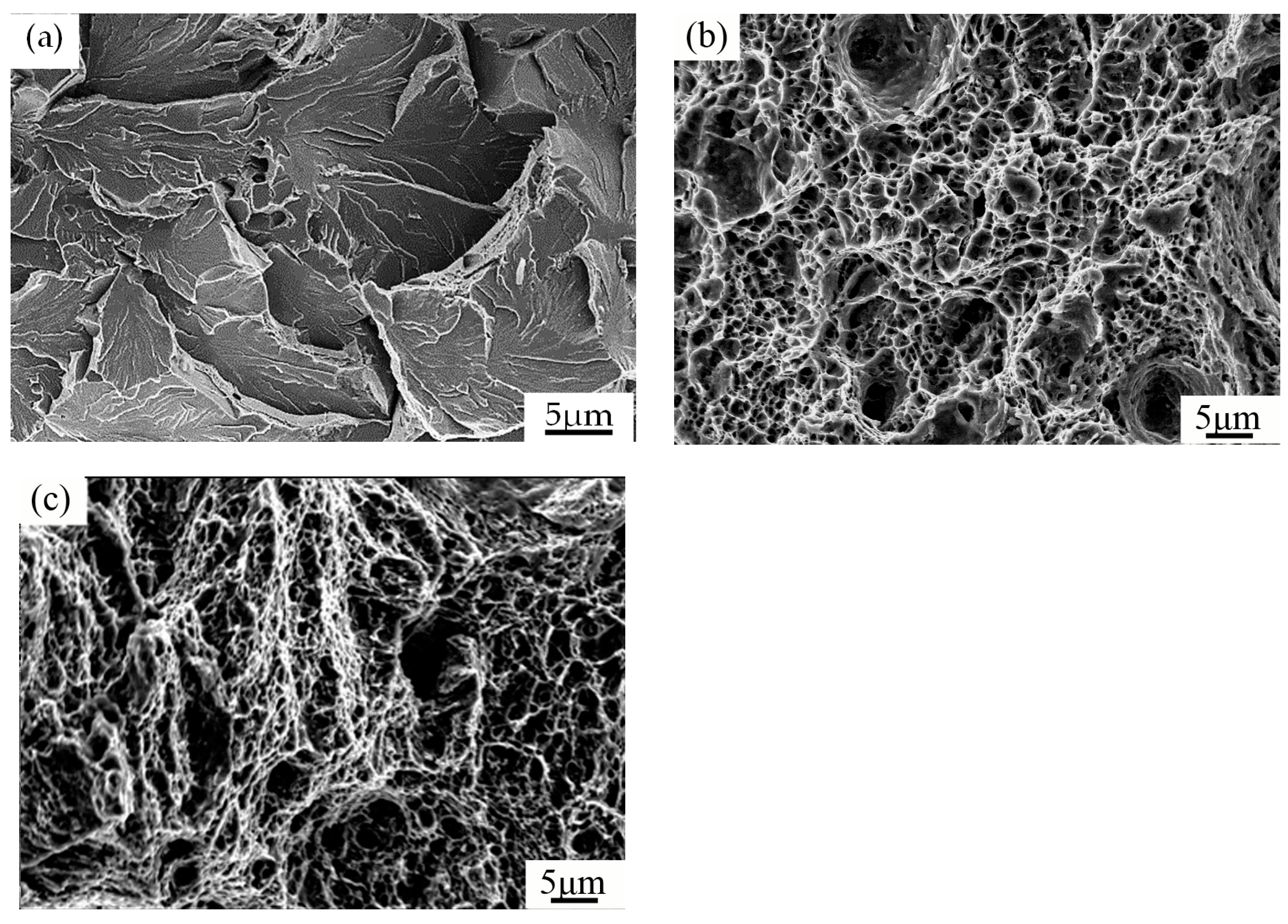
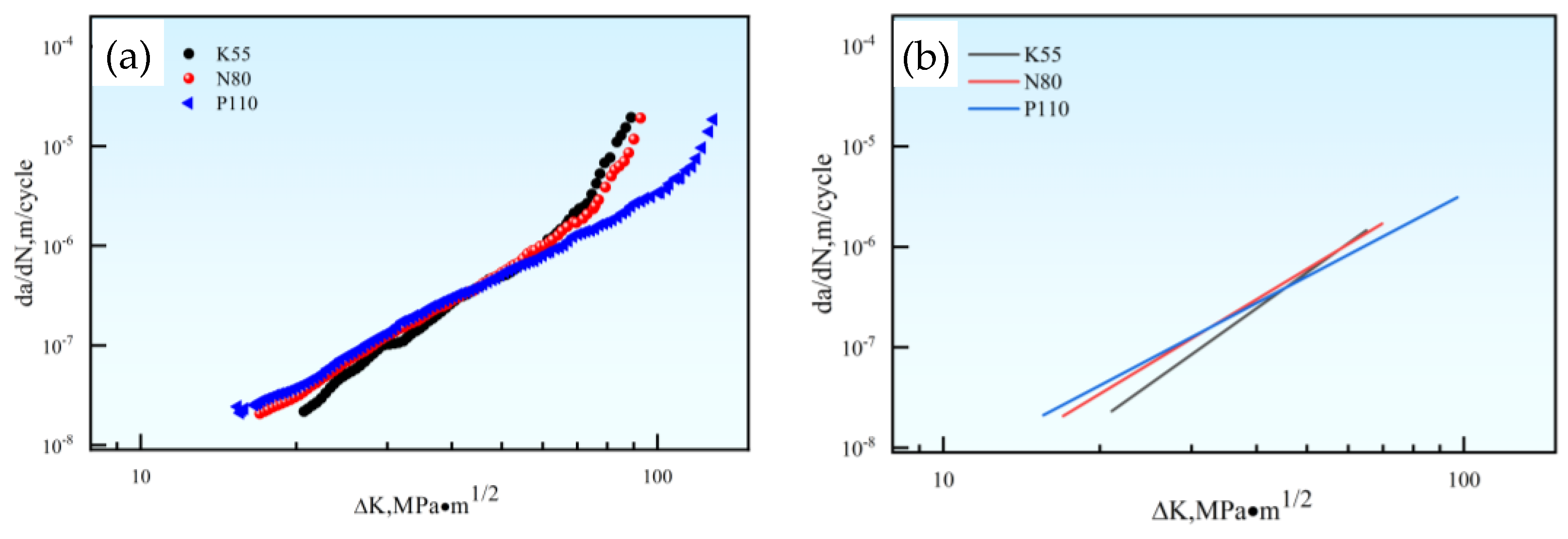
| Materials | K55 | N80 | P110 |
|---|---|---|---|
| C | 0.36 | 0.38 | 0.32 |
| Si | 0.32 | 0.23 | 0.23 |
| Mn | 1.51 | 1.38 | 1.47 |
| P | 0.025 | 0.015 | 0.013 |
| S | 0.0085 | 0.0076 | 0.0058 |
| Cr | 0.028 | 0.023 | 0.036 |
| Mo | 0.025 | 0.021 | 0.027 |
| Ni | 0.004 | 0.003 | 0.01 |
| V | 0.006 | 0.006 | 0.089 |
| Ti | 0.004 | 0.003 | 0.003 |
| Cu | 0.007 | 0.007 | 0.045 |
| Fe | Balance | Balance | Balance |
| Materials | Average Brinell Hardness (HB) ± Standard Deviation (S2.5 mm, 1837.5 N, 10 s) | Average Vickers Hardness (HV) ± Standard Deviation (0.49 N, 10 s) |
|---|---|---|
| K55steel | 198 ± 2 | 219 ± 20 |
| N80 steel | 214 ± 8 | 239 ± 31 |
| P110 steel | 273 ± 7 | 297 ± 7 |
| Materials | Yield Strength (MPa) | Tensile Strength (MPa) | Young’s Modulus (GPa) | Strain Hardening Exponent | Impact Energy Value (J) | Reference | ||
|---|---|---|---|---|---|---|---|---|
| σ0.2 | σ0.5 | σ0.6 | ||||||
| K55 | 403 | 414 | / | 708 | 206 | 0.2309 | 14.0 | This work |
| N80 | 559 | 565 | / | 732 | 199 | 0.1438 | 72.0 | This work |
| P110 | 808 | / | 816 | 898 | 191 | 0.0665 | 70.7 | This work |
| MHCS | 390.7 | / | 395.8 | 709 | 190 | / | / | [13] |
| MCS | 654 | / | 697.3 | 786 | 209 | / | / | [13] |
| P110s | / | / | 775 | 835 | / | / | / | [14] |
| K55 | 443.3 | / | / | 738.2 | / | / | / | [9] |
| N80Q | 565 | / | / | 728 | / | / | / | [15] |
| Materials | K55 | N80 | P110 |
|---|---|---|---|
| Paris constants m | 3.4965 | 3.1162 | 2.7257 |
| Paris constants C (×10−13) | 6.3 | 29.1 | 120.3 |
Disclaimer/Publisher’s Note: The statements, opinions and data contained in all publications are solely those of the individual author(s) and contributor(s) and not of MDPI and/or the editor(s). MDPI and/or the editor(s) disclaim responsibility for any injury to people or property resulting from any ideas, methods, instructions or products referred to in the content. |
© 2023 by the authors. Licensee MDPI, Basel, Switzerland. This article is an open access article distributed under the terms and conditions of the Creative Commons Attribution (CC BY) license (https://creativecommons.org/licenses/by/4.0/).
Share and Cite
He, X.; Zhang, M.; Xu, T.; Lei, L.; Li, Y. Evaluation of Mechanical Properties of Different Casing Drilling Steels. Metals 2023, 13, 427. https://doi.org/10.3390/met13020427
He X, Zhang M, Xu T, Lei L, Li Y. Evaluation of Mechanical Properties of Different Casing Drilling Steels. Metals. 2023; 13(2):427. https://doi.org/10.3390/met13020427
Chicago/Turabian StyleHe, Xiaoyu, Min Zhang, Tianhan Xu, Longyu Lei, and Yi Li. 2023. "Evaluation of Mechanical Properties of Different Casing Drilling Steels" Metals 13, no. 2: 427. https://doi.org/10.3390/met13020427






